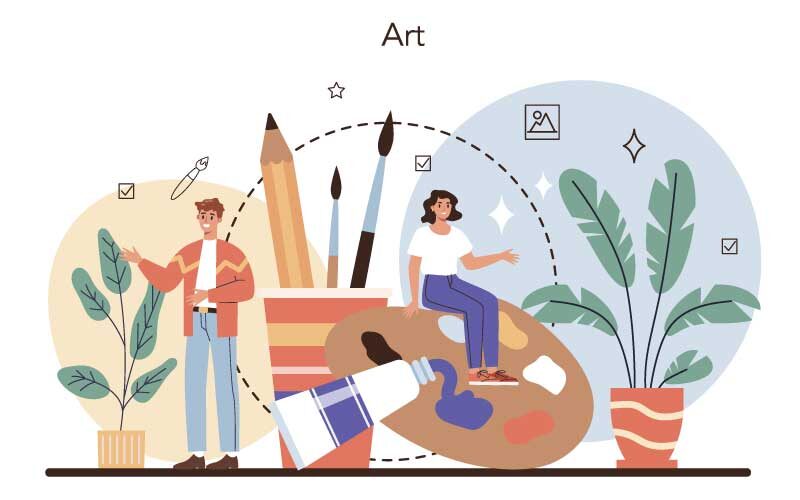Art management is a multifaceted discipline that plays a pivotal role in shaping the creative landscape of societies worldwide. It encompasses a wide array of activities, from curating exhibitions and managing artists to orchestrating cultural events and ensuring the financial sustainability of artistic endeavors. This essay explores the intricate world of art management, examining its significance in fostering creativity, promoting cultural diversity, and driving economic growth.
Art as a catalyst for societal change
All kinds of art have the capacity to elicit thinking, question accepted wisdom, and spur societal change. By serving as a conduit between the public and artists’ visions, art management promotes important social conversations. Art managers facilitate the expression of artists’ messages, feelings, and viewpoints by means of strategic planning and efficient implementation, therefore initiating conversations that have a worldwide impact. Art managers may facilitate good change by creating exhibits that tackle important societal issues and therefore increase awareness, empathy, and conversation (Kuesters, 2010).
Preserving cultural heritage
Art management also plays a crucial role in preserving cultural heritage. Many artworks are not just aesthetic expressions but bear historical, religious, or cultural significance. Art managers work towards conserving these treasures, ensuring their accessibility to future generations. Through meticulous conservation efforts, digitization, and educational programs, art managers safeguard cultural heritage, fostering a sense of pride and identity among communities. Preserving these artifacts not only enriches cultural knowledge but also promotes tourism and economic development (Tuan and Navrud, 2008).
Economic impact and entrepreneurship
Art management, an essential component of the creative economy, greatly boosts economic expansion. The performing arts, visual arts, cinema, and design are examples of the cultural and creative sectors that provide a significant amount of income and job possibilities. By putting artists in touch with patrons, collectors, and sponsors, art managers help to commercialize creative products and services. They also encourage entrepreneurship in the creative industry by giving artists the tools, connections, and resources they need to turn their interests into long-term professions. Art management fosters innovation and economic diversification by providing a supportive atmosphere for creative enterprise (Suchek, Ferreira, and Fernandes, 2022).
Cultural diplomacy and global understanding
In an increasingly interconnected world, cultural diplomacy plays a vital role in fostering global understanding and cooperation. Art managers, through international collaborations, exhibitions, and cultural exchanges, promote dialogue between diverse cultures. By facilitating the exchange of artistic ideas and traditions, art management fosters mutual respect and appreciation, breaking down barriers and promoting peace. These cultural exchanges not only enhance international relations but also promote tourism, creating economic opportunities for both participating nations (Ang, Isar, and Mar, 2015).
Challenges and ethical considerations
Even though art management has many advantages, there are drawbacks. It takes skill to navigate ethical issues like cultural appropriation, authenticity, and paying artists fairly. Furthermore, new issues with intellectual property, internet piracy, and the democratization of art dissemination have emerged with the advent of the digital era. In order to guarantee that artists’ rights are upheld and their work is valued fairly, art managers must adjust to these shifting dynamics (Chiaravalloti and Piber, 2011).
Conclusion
In order to foster creativity, protect cultural heritage, propel economic progress, and advance international understanding, art management is essential. Art managers make a substantial contribution to the vivid fabric of the creative world through strategic planning, ethical decision-making, and new techniques. Art management plays a crucial role in influencing the future of artistic expression and its global influence as the cultural environment continues to change.
Reference
Ang, I., Isar, Y.R. and Mar, P. (2015). Cultural diplomacy: beyond the national interest? International Journal of Cultural Policy, 21(4), pp.365–381. doi:https://doi.org/10.1080/10286632.2015.1042474.
Chiaravalloti, F. and Piber, M. (2011). Ethical Implications of Methodological Settings in Arts Management Research: The Case of Performance Evaluation. The Journal of Arts Management, Law, and Society, 41(4), pp.240–266. doi:https://doi.org/10.1080/10632921.2011.628210.
Kuesters, I. (2010). Arts Managers as Liaisons between Finance and Art: A Qualitative Study Inspired by the Theory of Functional Differentiation. The Journal of Arts Management, Law, and Society, 40(1), pp.43–57. doi:https://doi.org/10.1080/10632921003603976.
Suchek, N., Ferreira, J.J. and Fernandes, P.O. (2022). A review of entrepreneurship and circular economy research: State of the art and future directions. Business Strategy and the Environment, 31(5). doi:https://doi.org/10.1002/bse.3020.
Tuan, T.H. and Navrud, S. (2008). Capturing the benefits of preserving cultural heritage. Journal of Cultural Heritage, 9(3), pp.326–337. doi:https://doi.org/10.1016/j.culher.2008.05.001.
